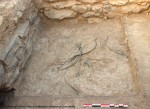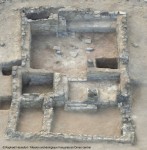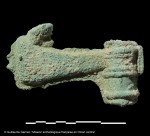 A team from the French Archaeological Mission excavating an Iron Age settlement near the town of Adam in northeastern Oman has discovered a cache of bronze weapons that were not usable as actual weapons. These are the first non-utilitarian weapons ever discovered in the Arabian Peninsula.
A team from the French Archaeological Mission excavating an Iron Age settlement near the town of Adam in northeastern Oman has discovered a cache of bronze weapons that were not usable as actual weapons. These are the first non-utilitarian weapons ever discovered in the Arabian Peninsula.
On the edge of the last oasis before the desert of Rub ‘al-Khali, the Adam area was virtually untouched by archaeologists until 2007 when the French Archaeological Mission first began to explore it. The mission’s fieldwork has unearthed a long human presence in the area: Lower and Middle Paleolithic occupation, a Neolithic settlement, two Bronze Age burial grounds and a group of Iron Age buildings at the foot of the Jabal Mudhmar mountain.
 Dubbed Mudhmar East, the Iron Age site was discovered in 2009. It has two large buildings and several smaller ones. The larger of the two main buildings, about 50 feet long, is made of sandstone blocks and mudbricks and is divided into multiple rooms. One small room mid-way through the building on the side is entirely enclosed, with no doorway to the interior or exterior. It was in that room that archaeologists discovered a cache of bronze weapons during the 2015 excavation season. The objects date to the Iron Age II period (900-600 B.C.). The placement of the artifacts indicate they were not originally on the floor, but rather fell from shelves or possibly the walls.
Dubbed Mudhmar East, the Iron Age site was discovered in 2009. It has two large buildings and several smaller ones. The larger of the two main buildings, about 50 feet long, is made of sandstone blocks and mudbricks and is divided into multiple rooms. One small room mid-way through the building on the side is entirely enclosed, with no doorway to the interior or exterior. It was in that room that archaeologists discovered a cache of bronze weapons during the 2015 excavation season. The objects date to the Iron Age II period (900-600 B.C.). The placement of the artifacts indicate they were not originally on the floor, but rather fell from shelves or possibly the walls.
Within this collection of objects, two especially remarkable groups stand out. The first one consists of two small quivers entirely made of bronze, including the six arrows contained in each of them. Given their size (35 cm) [14 inches], these were small-scale models imitating the original objects made of perishable materials (leather), which are not usually found in archaeological excavations. The fact that they are made of metal implies that they were non-functional. Quivers of this kind have never been found in the Arabian Peninsula, and are extremely rare elsewhere.
The second group comprises metal weapons, which were mostly non-utilitarian (given their slightly reduced size, material and/or unfinished state). They consist of five battle-axes, five daggers with crescent-shaped pommels (characteristic of the Iron Age II), around fifty arrowheads, and five complete bows. The bows are made up of a flat, curved bowstave bent at both ends, which are connected by a string made of bronze.
The size of the bows (70 cm [28 inches] on average), and above all the material used, shows that they were imitations of bows made of perishable materials (wood and tendons). Objects of this type have never been found before: bows made of metal were totally unknown in the Arabian Peninsula and the Middle East until now.
Since we know so little about the site and the weapons are unique, the French Archaeological Mission experts are not sure what their purpose was. The discovery of fragments of incense burners and snake figurines in the second large building suggest it may have been used for religious purposes. If so, the weapons may have been offerings to a war deity. Alternatively, they may have had some other function in this Iron Age society that archaeologists have yet to understand.
 Meanwhile, the bronze weapons reveal much we don’t know about utilitarian Iron Age weaponry. They’re made out of different material, but the designs and types are the same as the kind of weapons people used in battle and the hunt. They were fabricated during a period when metallurgy in the eastern Arabian Peninsula was on the rise. The development of the craft paralleled a growth in societal complexity, reflected in the construction of monumental, fortified structures in Iron Age settlements.
Meanwhile, the bronze weapons reveal much we don’t know about utilitarian Iron Age weaponry. They’re made out of different material, but the designs and types are the same as the kind of weapons people used in battle and the hunt. They were fabricated during a period when metallurgy in the eastern Arabian Peninsula was on the rise. The development of the craft paralleled a growth in societal complexity, reflected in the construction of monumental, fortified structures in Iron Age settlements.
Excavations at Mudhmar East are ongoing. Archaeologists are hopeful they will reveal more about Iron Age societies in the Arabian peninsula, the nature of the site and what role the non-utilitarian weapons played.
Since metal was considered very valuable at that time this is a little mystery. If the place had been taken by hostile act they would have taken stuff just laying around (unless) there was a counter attack and they were driven off mid looting). Again if the inhabitants had just moved for some reason why leave the stuff?
I’m sure someone has thought of this, but if religious, where is an altar and/or god figurine. I don’t think they would be toys and it would be very unusual if they were for training purposes.
Very interesting!
unusable floor samples. retail stores do it all the time.
In Oman, one would expect ‘incense burners’ and ‘snake figurines’ allover. Bronze Age metallurgy in an Iron Age environment is probably also not entirely state of the art. I wonder, therefore, if there were indications for a workshop. Those items might have been trade- or grave goods.
Maybe we are dealing with some form of Bric-Arab Middle Eastern souvenir store ? – ‘O Man, I survived Oman – and brought tiny weapons !’ (i.e. items fallen ‘from shelves or possibly the walls’), maybe it was a weaponry trade-fair – Without more context, it might be hard to tell.
Bronze-made ‘bows’ that more or less do resemble little composite bows (relaxed, without sinews) have in 2015 unearthed in Bavaria, and those seem to have been used as ingots and/or primitive money, seemingly as an alternative to those Bronze Age precious metal spirals.